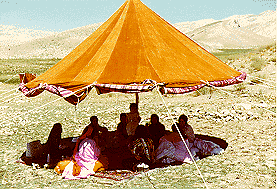


By Behrouz Bahmani
San Ramon, California
One of the things I am most proud of as an Iranian is my heritage as a Qashqaie. The Qashqaie tribe is made up of nomadic herdsmen whose origins can be traced all the way back to the Mongolian invasion.
As the invasion began to wane, some of the Mongols did not return and made their home in what is now Iran. This is why there are so many similar tribes, such as the Turkmans, who have the most pronounced Asian features.
The Qashqaies currently number in the neighborhood of half a million and reside in the central part of the Isfahan-Shiraz corridor, bordering on the Zagros mountain range. Their customs and traditions have yielded a unique brand of the Turkic language, distinctive music, a dazzling style of carpet weaving, and a rich culture and heritage filled with a fiery lust for life and freedom.
My first exposure to the tribe was in the late winter of 1963 soon after I first stepped off a plane and planted my little foot on the snow-covered runway of Mehrabad Airport in Tehran. I was 3 years old. I cannot of course remember what happened but my mother's recollections have remained in my mind.
My father had been away for seven years doing his university studies in the U.S. Upon arrival, he made the necessary arrangements for us to go to Shiraz and then to the nearby town of Firooz Abad. A few kilometers outside was a little village named Jahe-Dasht, where his family had lived for generations on a small farm.
Many Qashqaies have such farms from which they base their nomadic sojourns. The Nomadic style of life revolves around the herd's migrations or kouch , which take place around summer and winter seasons. During early spring, the tribe begins to move the herds from the warm winter pastures or garm-seer in the southern plains, to the cooler summer pastures or sard-seer in the northern mountains.
The trip takes the whole spring. In the summer, the trip is reversed and during the fall, the tribe moves the herd back toward winter pastures in the south. It is an admirable demonstration of organization, navigation, confidence and sheer will.
Traveling to such a place in Iran in the early '60s was a feat short of miraculous and I am sorry to say that even today this is still quite a haul. The trip began early in the morning with the hope that we would make Jahe-Dasht sometime that evening. I am told I was well-behaved for most of the trip and enjoyed sleeping in the back seat of my father's new Karmann-Ghia.
We arrived shortly after 2 a.m. at my father's family farm. There was no electricity, so fires had been lit and lanterns which hung everywhere cast an eerie orange glow on the faces of the people who had thronged to greet us.
As we entered the garden driveway in our car, a roar erupted as drums began the traditional wedding beat "deembolo-deembo, deembolo-deembo" joined by the high-pitched nasal "saz" and the women dressed in their fiery bright colored dresses and scarves joined with high-pitched, "tyeeeleeeeleeeleeeleee!"
My mother and I did not know that this was a traditional wedding cheer given a bride and groom upon their first arrival. I immediately and without hesitation began screaming at the top of my lungs, certain that I was about to be eaten alive.
My mother, father and soon-to-be-introduced relatives began laughing as they hugged and kissed me and tried to reassure me that they were friendly natives. No such luck.
I finally had to be restrained and ultimately removed from the proceedings as my father greeted his father and mother and sisters and brother. I fell asleep sobbing in tears with my mother stroking me on the back.
The next morning I woke up to loud braying and the smell of smoke. I peered out of the main building window we were in and saw the early morning servants scurrying about preparing for breakfast. I was hungry from crying and was a little more agreeable to meet new faces now that it was daytime and food was at hand.
We sat down on a carpet at our place on a tablecloth which had been spread out for us and the food began arriving. First, there was fresh milk warmed and sweetened with honey. Next, fresh yogurt, butter, cheese and homemade sour-cherry jam. Fire-baked bread began piling up and farm eggs which had been fried to a crisp outside began dropping onto our plates.
Afterward I warmed up nicely to my new relatives and began playing with some of my cousins. They took me and showed me the farm which I was pleased to find was full of animals. I even managed to find the source of the braying which had waken me earlier: A baby donkey. He was already home. I had just found mine.